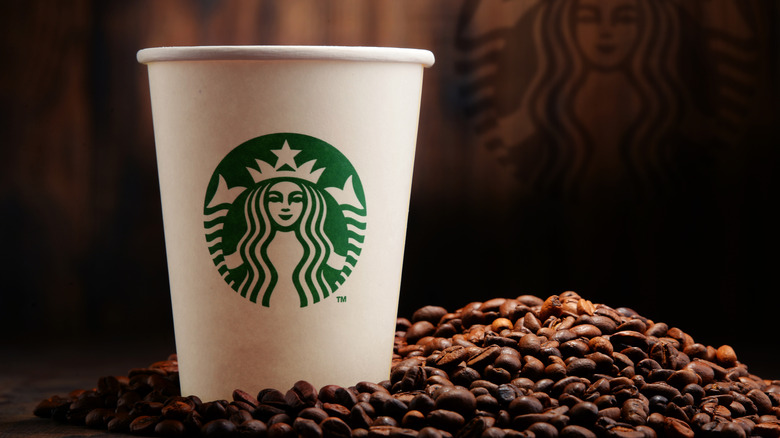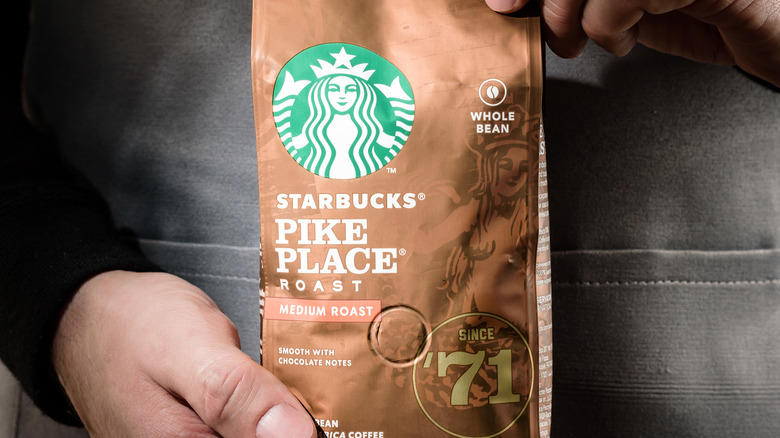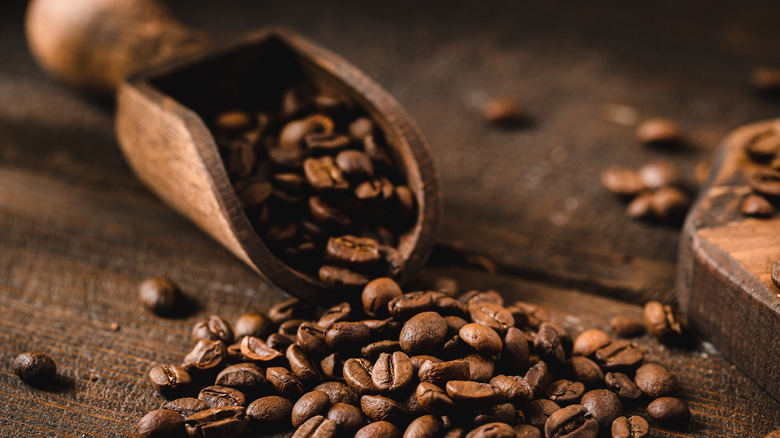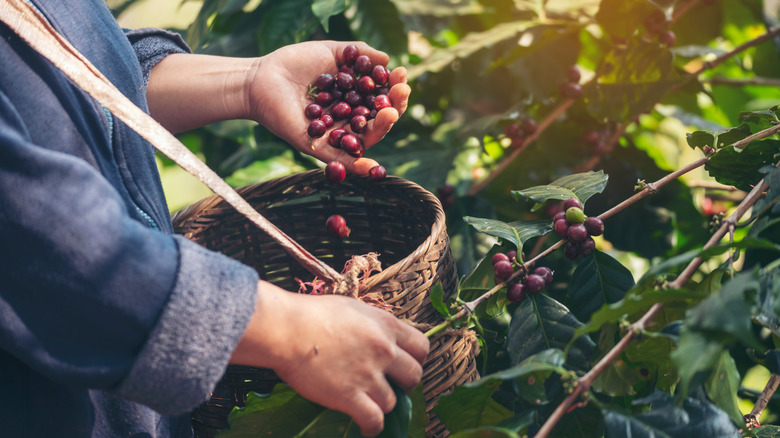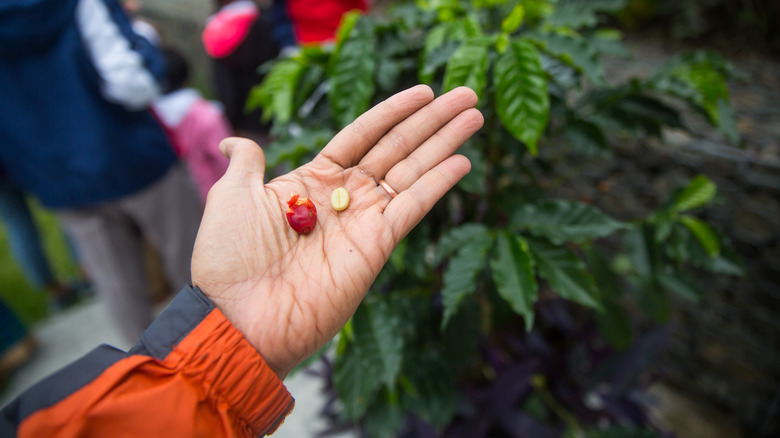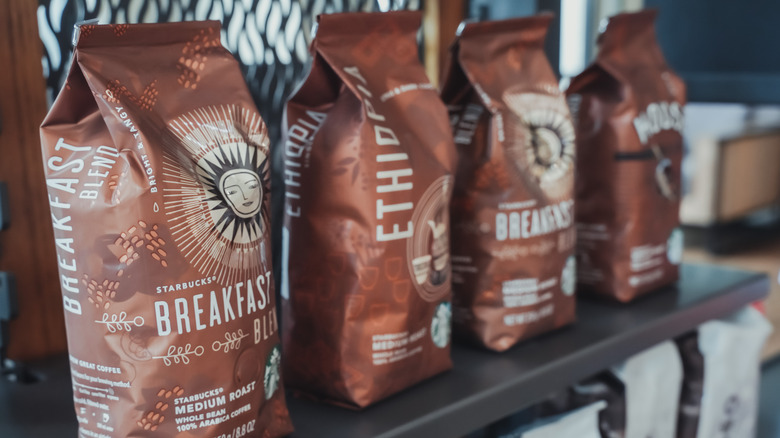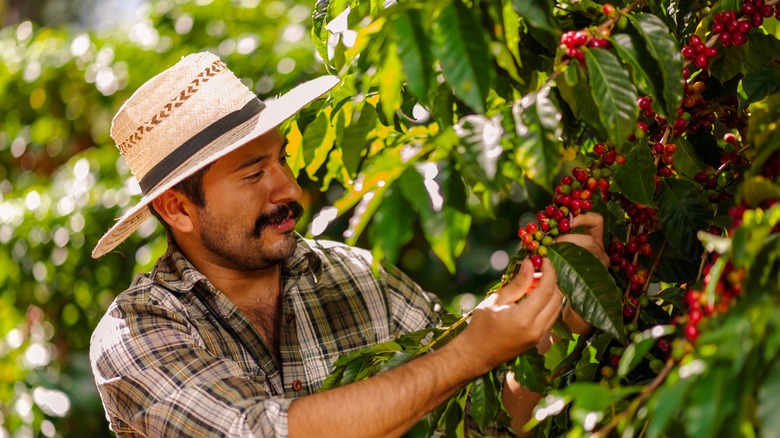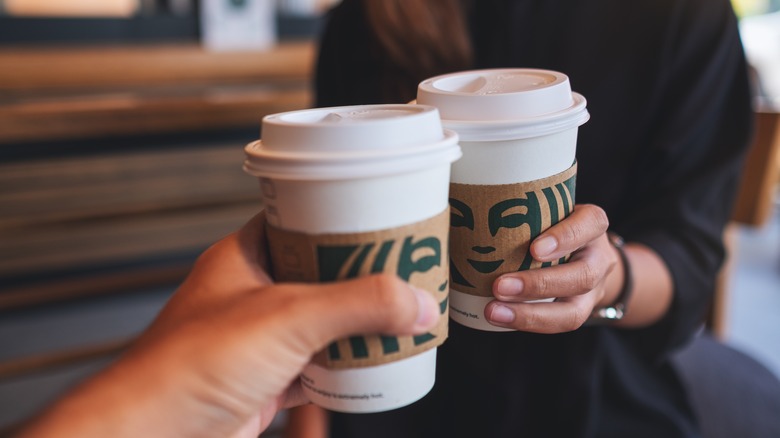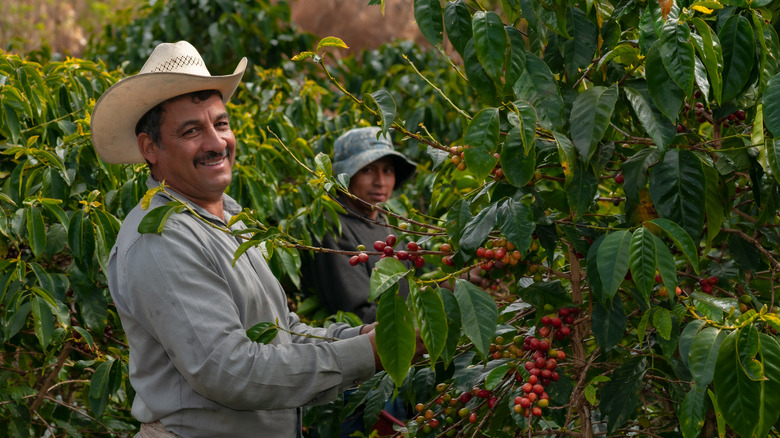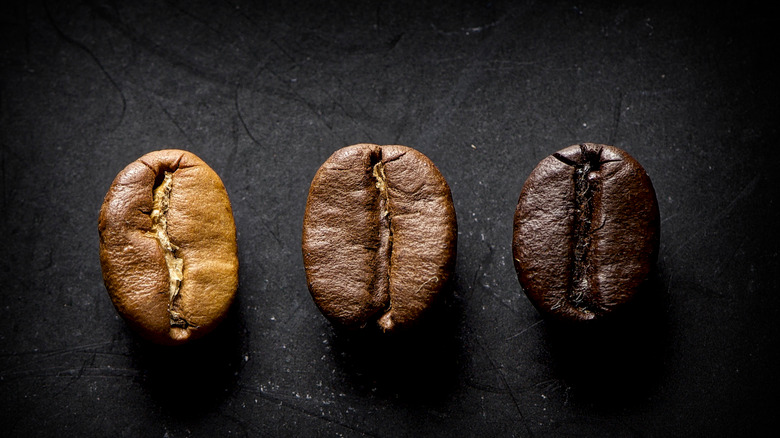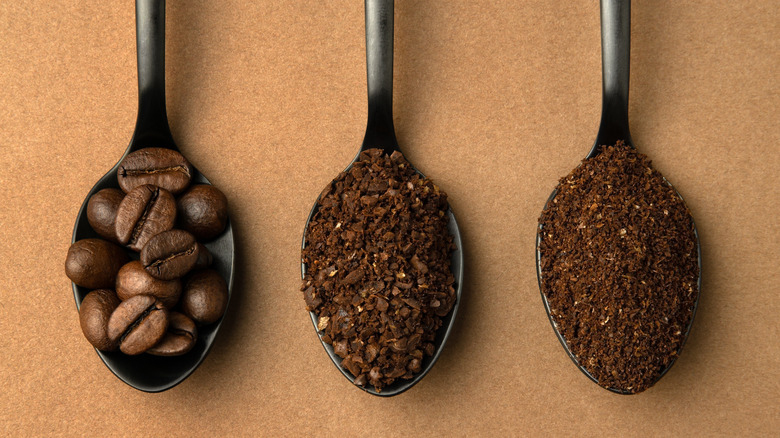10 Facts You Should Know About Starbucks Coffee Beans
There's nothing like a cup of Starbucks coffee. For some, that could mean a steaming hot cup of dark roast, uninhibited by syrups or creamers, and, for others, that could mean a double whip, dirty mocha Frappuccino with caramel drizzle and pumpkin spice. Either way you play the game, we can all agree that there's something quite comforting and consistently delicious about the brand, and the way it sources and prepares its beans. Otherwise, we'd be on time to work, and the line outside of Starbucks wouldn't be stopping traffic. But what makes those Starbucks beans so special? There's a lot that goes into the growing, production, and selection of beans that it uses, so we've listed all of the facts you should know about Starbucks coffee beans.
Even for those of us who have taken the sage advice to just make coffee at home and have picked up a bag of beans from Starbucks, we know that we can expect that same top-tier quality. Like any major roaster, Starbucks has specific protocols and standards that it holds its farmers and production facilities to. The beans are typically regarded as higher quality than Dunkin' or Tim Hortons. Let's get into why Starbucks coffee is so desirable. Besides incredible marketing, it all boils down to one thing in the end: the beans.
Starbucks uses FlavorLock technology to keep its beans fresh
Are you choosing which brand of coffee to buy at the grocery store? The options are usually quite extensive, but there's a reason that we tend to gravitate towards a slightly more expensive, but higher quality brand, like Starbucks. Part of it has to do with the quality of the beans itself, but an equally important aspect to consider is how fresh those beans are. If you've ever found a bag of beans in the back of your pantry and given them a grind and brew, then you're likely quite aware that after time, the flavor of coffee changes and fades. Those expiration dates are on there to ensure you're getting the most out of your bean and that the natural oils haven't gone rancid. Luckily, Starbucks has discovered a technology to help keep those sealed beans fresher for longer. The company calls it FlavorLock technology, and it's how Starbucks uses packaging to keep its coffee beans fresh for so long.
So what does FlavorLock really mean? This sealing method ensures that your beans can last up to 34 weeks in a sealed bag without taking a hit when it comes to flavor. The key to its success is that each bag contains a one-way valve, which lets carbon dioxide out but doesn't let any oxygen in. By minimizing oxygen exposure, Starbucks is ensuring that any beans sealed with FlavorLock won't oxidize, and will hold onto that bold aroma.
The company seals its beans within two hours of roasting
An important element of the quality of Starbucks coffee beans is ensuring freshness. It has nailed the packaging method, but there's another step that must be taken before the beans are ready to go into their bags. After the extensive roasting process, Starbucks beans have a quick turnaround before being sealed away. Starbucks knows that long exposure to oxygen tampers with the flavor of the beans, so it aims to seal its beans within two hours of roasting. This gives the beans a chance to cool and rest before heading into their FlavorLock bags. This not only helps keep direct-to-customer sales fresh but also helps the company send coffee from its roasters to cafes all over the country.
Because so much work goes into ensuring that Starbucks beans are sealed up with all of their flavors, it's important for the consumer to do their part in preserving the magic. Don't open your bag until you're ready to start brewing, no matter how tempting it might be to take that inaugural whiff. Next, be sure to store the coffee in a sealed opaque bag, in a dry, dark, room-temperature location. Don't leave the bag open on the countertop; instead, roll your bag tightly, or use an airtight container made for coffee.
Its beans come from the coffee belt
Most of the world's coffee is grown in a specific climate, which is why you might not be able to grow your own beans in your own backyard. Between the Tropics of Cancer and Capricorn, there lies a climate that best supports the growth of coffee bushes, and it's referred to as "the coffee belt." Along this belt, there are more than 70 countries where coffee plants flourish. Starbucks imports beans from 30 of these countries.
The coffee belt is broken into three main areas including Latin America, Africa, and Asia and Pacific regions. Starbucks uses beans from each of these areas, in order to provide a diverse profile of beans, all with unique undertones of flavors specific to their region. Latin American coffee tends to have a soft spice, with undertones of nutty cocoa which is also native to the area. Asian and Pacific Island coffee has an earthier flavor and is quite robust and botanical. African coffee has more of a range and tastes almost berry-like and fruity. Of course, each specific region, and each specific grower has their claim to fame on the flavor spectrum. Starbucks does its best to mix and match accordingly and supply its customers with knowledge about the flavor it's purchasing. The best way to find your preferred flavor is to try them all.
There's even a coffee bean farm
While most Starbucks beans come from coffee farmers all over the coffee belt, there is one special farm that is owned by the company. In Costa Rica, where the Starbucks farm is located, the soil is extremely rich from volcanic action, which grabbed the attention of the company. The farm, Hacienda Alsacia, is used to grow coffee bushes but is also a place where the company carries out research and development practices. It is Starbucks's only farm, making the beans sourced there quite unique, and different from the other imported farm-grown beans from around the world.
Hacienda Alsacia is surrounded by coffee farms and isn't too far from San Jose. It's an open farm, meaning Starbucks allows visitors from all over to check out its growing and production process. For those interested in the growing and production of coffee, the tours make for an incredible vacation attraction, and who doesn't love being outside in the sunshine learning about their favorite pick-me-up beverage? If you can't make it all the way to Costa Rica but are interested in learning more about Hacienda Alsacia, Starbucks offers a virtual tour online. This option may be especially intriguing for those who need a visual escape from a snowy winter or would like to set the mood as they sip a freshly brewed Starbucks Coffee, grown in the rich soils of Hacienda Alsacia.
Starbucks never freezes its beans, and you shouldn't either
It's important that coffee is fresh in order to be as flavorful as possible. Some foods are best preserved in the freezer. And while this works well for leftovers and meat, it's not necessarily a great idea for coffee beans. Even though Starbucks imports its beans from all over the world, it wouldn't dare turn to a freezer for flavor preservation. It doesn't freeze its beans, but instead roasts them and transfers them directly to FlavorLock bags. Starbucks doesn't recommend that you freeze your beans either, or even refrigerate them, and here's why.
Coffee beans should be kept dry, and as they absorb moisture, it changes their flavor. If you're brewing fresh cups of Starbucks coffee daily, then there is no need to try and preserve the beans, passed keeping them in a sealed container in a dry area. Wondering if it's ever okay to store coffee beans in the freezer? This should only be done as a last resort, like if you're going out of town for a few weeks, or are giving up caffeine but want to keep a bag on hand for guests. Note that it will compromise the flavor to a degree. We should all take a page out of Starbucks' playbook for keeping beans as fresh as possible.
All the beans are 100% Arabica
The two most popular types of coffee beans grown around the world are arabica and robusta. They come from bushes grown at different elevations, which dictate how fast the fruit develops, which eventually results in a difference in flavor. Arabica beans are grown at a higher elevation, resulting in slower development. Once they are roasted, they tend to be less bitter and instead fruitier. This is the reason Starbucks only uses arabica coffee beans because they are superior when it comes to flavor. Arabica beans do contain less caffeine than robusta but tend to be more complex, with elegant and deep undertones. Robusta is the type of coffee bean most commonly used in instant coffee, which doesn't have a reputation for being particularly rich or high class.
Folks often find arabica to be smoother and slightly sweeter, with a higher acidity that adds to the overall flavor. Unless caffeine content is your main concern, there really is no downside to using exclusively the arabica bean, which is why Starbucks has chosen this course. Although it's more universally enjoyed and drinkable, personal preference should be the driving cause of your bean selection. Like wine, coffee, cheese, or olive oil, preference in flavor is subjective, so if you prefer a slightly more bitter selection with a higher caffeine content, then Starbucks may not be your brand.
The bean blends vary greatly in flavor
When you grab a bag of joe and the beans are described as floral or earthy, it may be difficult to determine just what bean blend pairs best with your palate. Like a wine connoisseur, or someone who can distinguish different notes in extra virgin olive oils, those who enjoy coffee are often able to detect subtle differences in blends. These undertones of flavor have quite a bit to do with the plants and where they are grown. Some coffee bushes that grow in acidic soil or volcanic soil are distinguishable from those that are more alkaline. In addition, the climate where the bush grows can be a determining factor. Starbucks does its best to describe these blends so that we can choose our preferred beans accordingly.
Although it's all up to personal preference, a general consensus can be made about some of Starbucks's blends, which is why we were able to rank Starbuck's ground blends from worst to best. Among some of the most universally loved favorites was the classic French Roast, which is its darkest roasted blend. It's made from a mix of beans from the South American and the Asia-Pacific regions and has a deep boldness to it that customers just seem to love. Another bold classic is Sumatra, with beans grown in Indonesia. It offers undertones of berries and floral notes, along with low acidity, and is quite mellow for a dark roast.
Beans are sourced with farmers in mind
Ever see that "Fair Trade" symbol or text on the side of your tea, coffee, or chocolate bar? Although you might not need to know everything there is to know about fair trade-certified coffee beans, the most important key points are as follows. Its main purpose is to combat the exploitation of laborers and farmers. It does this by ensuring they make a fair wage. In addition, fair trade coffee lives up to a certain quality standard, ensuring the consumer is getting a premium bean. While most roasters use the Fair Trade certification system to determine if the beans are ethically sourced from farmers, Starbucks has its own system. It practices C.A.F.E. instead, so technically, Starbucks is not Fair Trade certified.
C.A.F.E. stands for Coffee and Farmer Equality Practices, according to Starbucks. It covers the ethical practice of sourcing beans from fairly paid farmers, similar to Fair Trade. It aims to protect the well-being of not only its farmers but the communities where the coffee grows. In addition, there is an environmental focus, ensuring that the farms are not harming the local biodiversity or water supplies while trying to keep up with demand.
Three main ways it roasts its beans
Unless you're a coffee connoisseur, then it's likely you've chosen your preference in roast based on a few good or bad experiences. Maybe you just stick to the coffee you grew up on that your parents preferred. Or maybe you like to mix it up and don't really know the difference between a dark or light roast. As it turns out, there is quite a bit that goes into the outcome of the flavor of a cup of joe. It all starts with the coffee plants themselves and ends with the roasting process. Starbucks has three types of roasts: Blonde, medium, and dark roast. The company's coffees vary on a spectrum, but fall into one of these three categories, making it easier for the consumer to target exactly what they enjoy. There are plenty of blends in each category, so it's possible to refine your preferences even further.
Starbucks Blonde Roast is made with beans that have been roasted for the least amount of time. They are described as "smooth and flavorful" by the company and are a great option for those who prefer a mellow, easy-sipping coffee. Starbucks Dark Roast has been roasted for the most amount of time, and is "rich and bold." It has more depth and is preferred by those who enjoy the intensity of dark chocolate. No surprise that Medium Roast falls right in the middle, with a smooth yet rich flavor.
You can purchase the beans whole or ground
There are many places where you can purchase Starbucks beans, including at most grocery stores, online, and, of course, at Starbucks cafes. Once you've decided on a type of roast and a blend that lives up to your standards, the next step is to choose if you'd like your beans pre-ground or whole. This decision might be made for you if you don't have a coffee grinder at home. However, it may be worth it to make the splurge, because there is a scientific reason that coffee tastes better from freshly ground beans. Grinding the beans causes off-gassing which is the release of CO2. When this happens, it compromises the flavor, which fades over time. Beans are best enjoyed within a week of grinding, so if you are able to grab a bag of Starbucks whole beans, you may be in for an elevated flavor.
If not, there are plenty of grinds to choose from. If you go to a cafe, Starbucks will freshly grind your coffee for you. You can choose from coarsely ground, medium-course, medium, medium-fine, fine, and extra fine. Depending on what kind of coffee machine you're working with, you'll want to choose your grind accordingly. For instance, the absolute best grind size for automatic drip coffee is medium-course, while you'll want to go with a fine grind for espresso. If you're unsure which direction to go in, ask your local barista.
